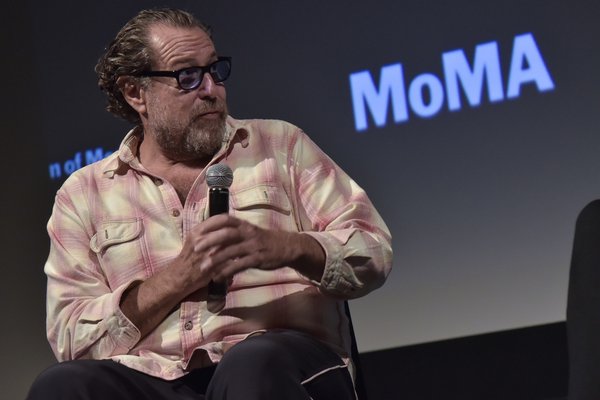
In recent years, virtual reality in film has been the talk of the town. There’s a lot of hype over the new technology, which allows audiences to feel completely immersed in what they’re watching.
But for distinguished artist and director Julian Schnabel, the concept isn’t new—it’s 10 years old this year.
During a special screening on June 29 of his 2007 Oscar-nominated “The Diving Bell and the Butterfly”—sponsored by the Museum of Modern Art and the Hamptons International Film Festival in honor of HIFF’s 25th year—Mr. Schnabel said it was “funny” that he was recently asked to make a virtual reality movie.
“I thought I already did it without virtual reality,” Mr. Schnabel said, referring to the special electronic equipment—sometimes a headset, gloves or even treadmills—that’s often needed for audiences to feel immersed in an environment. “I didn’t know what to do with the camera so I figured, use it in some other way—it’s very experiential.”
Indeed, the emotionally intense and critically acclaimed “The Diving Bell and the Butterfly”—the film won two Golden Globe Awards, was nominated for four Academy Awards and Mr. Schnabel won best director at the 2007 Cannes Film Festival—is shot from the first-person perspective of Jean-Dominique Bauby, a successful Elle magazine editor and author. At 43, Mr. Bauby suffered a stroke and was completely paralyzed except for his left eye. He couldn’t move or speak—a friend called him a “vegetable”—but his mind was unharmed. With a clear sense of humor, he even wondered what kind of vegetable he might be.
“Other than my eye, two things aren’t paralyzed: my imagination and my memory,” Mr. Bauby says in the film. He was able to write his memoir by blinking, spelling out full words, letter by letter, and then stringing them together to form sentences with the help of his speech therapists. Mr. Schnabel’s movie is based on the memoir, which was published just 10 days before Mr. Bauby died in 1997.
“The possibilities that got opened up—essentially he could imagine whatever he wanted to, and in that he could go anywhere and he could do anything,” Mr. Schnabel said of Mr. Bauby. “I could put anything in the movie that I wanted to.”
Mr. Bauby’s stroke left him with “locked-in syndrome” and was expected to keep the glamorous, often self-indulgent author trapped inside his own body. But in a twist of fate, Mr. Bauby was instead liberated. The film takes him and the audience to all sorts of places he’d never been before—with a deep breath in, for example, his imagination lands him in the deserts of Egypt and then the icebergs of Antarctica.
“Through his sickness—in the same way that if you couldn’t walk, you do upper body strength—he developed an access that he never had before in his life,” Mr. Schnabel said. “I guess what I tried to do is to show that through his work he could free himself.”
“I wouldn’t have thought that being locked-in would’ve been the thing that triggered it,” said Rajendra Roy, the chief curator of film at MoMA.
To make the film so realistic, it took not only sophisticated visual frames but also precise sound design. Mr. Schnabel himself stayed at Berck-sur-Mer, the seaside hospital in France where Mr. Bauby was housed. Several of Mr. Bauby’s real doctors even starred in the movie, including his physiotherapist. “I said, ‘Everybody’s in the movie—whoever isn’t working can come and be in the movie,’” Mr. Schnabel recalled, smiling.
He had to get all the details right. Mr. Schnabel asked the nurses at the hospital about every possible scenario from Mr. Bauby’s stay there. For instance, when he looked at Mathieu Amalric—who played Mr. Bauby—lying on the bed, he asked the nurses about the position of Mr. Bauby’s hands. The nurses then remembered a seemingly minor detail, that there had been “sponges” and “foam things” under his hands to prevent contractures. Mr. Schnabel then ensured that the “foam things” were used in the film. The same went for the noises in the room, and the nurses realized there had been a humidifier nearby to keep Mr. Bauby’s skin moist.
“Essentially I knew nothing about the science of all that, but just by asking what happened here and being in there, I guess it just became … real,” Mr. Schnabel said. “I like to think that nobody’s acting and it is real—and I felt like it was real to me.”
In one especially harrowing scene in the beginning of the film, the audience experiences from Mr. Bauby’s perspective the sewing shut of his right eye because doctors wanted to prevent infection. Viewers see stitch by stitch, through eyelashes and all, another part of Bauby’s world go dark. It couldn’t have been more real.
“It was really liberation of the camera,” Mr. Schnabel said.
“This film works as well today as it did the day it came out,” said David Nugent, the artistic director of HIFF. “I remember distinctly sitting in a screening room with five other people watching, and we were transported—I love this movie.”
Mr. Schnabel is now preparing to make a movie about post-impressionist painter Vincent Van Gogh, called “At Eternity’s Gate.” The film will speak to the painter’s understanding of and relationship to art.
HIFF held this screening in celebration of its 25th year. The nonprofit has picked a film for each year that the festival has been in existence, and has been showing them all over the country, including in the East End, New York City, Los Angeles and Palm Beach. Many of the screenings have included conversations with some of the films’ artists.
“‘Diving Bell’ is not a very conventional film, which is why we love it—we’re trying to find films that stretch people’s ideas of what movie making can be,” Mr. Nugent said.